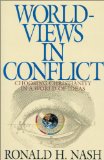Worldviews in Conflict: Choosing Christianity in a World of Ideas. By Ronald H. Nash. Grand Rapids: Zondervan Publishing House, 1992. 176 pp. Paper, $10.99.
Christianity is only one of seven worldviews. According to Ronald Nash a worldview is “a conceptual scheme by which we consciously or unconsciously place or fit everything we believe and by which we interpret and judge reality.” All people consciously or unconsciously have a worldview or a way in which they see the world and interpret things around them.
Worldviews in Conflict is an easy-to-read defense of the Christian worldview. In the first two chapters the author defines worldview and presents the Christian worldview. Chapter 3 covers three tests (reason, experience, and practice) for determining the truth of a worldview.
Nash points out that Christianity has a much better answer to evil than do naturalism or the New Age movement. In naturalism there is no God. Nothing exists outside the material, mechanical, natural order. However, if this is true then there is no ground whatsoever for saying something is evil or good. Morals must be relative. This is completely contrary to our experience and unlivable in the real world. Morals come from persons. People are relative since they are mortal. In order to have absolute morals there must be an absolute Law Maker. Most Naturalists believe that murdering innocent children, stealing, and lying are wrong, but they do not have philosophical foundations on which to rest that belief.
The New Age movement is primarily represented by the pantheist worldview: “everything is god and god is everything.” The problem with this theory is that if god is everything then He is also good and evil, thus obliterating the distinction between the two. Evil actually becomes an illusion.
Nash shows that these two worldviews do not pass the test of reason, experience, or practice. The Christian worldview is one of the only worldviews that provides an answer for evil. God made the world good and allowed evil in it for a good reason of His own. For reasons of logical consistency it does not matter what that reason was. The Christian view recognizes a real evil and good. Thus they can be dealt with.
The last chapter shows that Jesus’ incarnation and resurrection are more probable than the other options.
It would have been better had the author covered the other four worldviews (determinism, logical positivism, physicalism, and evidentialism), although they are not as popular as the three he did cover. This book is an excellent introduction into worldviews and how to defend the reasonableness of Christianity.
R. Michael Duffy
Missionary
The Hague
Netherlands

